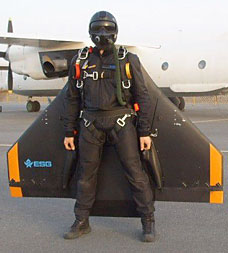Special forces to use strap-on 'stealth wings'

Elite special forces troops being dropped behind enemy lines on covert missions are to ditch their traditional parachutes in favour of strap-on stealth wings.
The lightweight carbon fibre mono-wings will allow them to jump from high altitudes and then glide 120 miles or more before landing - making them almost impossible to spot, as their aircraft can avoid flying anywhere near the target.
The technology was demonstrated in spectacular fashion three years ago when Austrian daredevil Felix Baumgartner - a pioneer of freefall gliding - famously 'flew' across the English Channel, leaping out of an aircraft 30,000ft above Dover and landing safely near Calais 12 minutes later.
Wearing an aerodynamic suit, and with a 6ft wide wing strapped to his back, he soared across the sea at 220mph, moving six feet forward through the air for every one foot he fell vertically - and opened his parachute 1,000ft above the ground before landing safely.
'Massive potential'
Now military scientists have realised the massive potential for secret military missions.
Currently special forces such as the SAS rely on a variety of parachute techniques to land behind enemy lines - or else they must be dropped by helicopter.
Existing steerable square parachutes can be used - opened at high altitude of 27,000 ft - but jumpers then have to struggle to control them for long periods, often in high winds and extreme cold, while breathing from an oxygen tank to stay alive.
Alternatively they can freefall from high altitude, opening their parachutes at the last possible minute, but that limits the distance they can 'glide' forward from the drop point to just a few miles.
Now German company ESG has developed the strap-on rigid wing specifically for special forces use.
Resembling a 6ft-wide pair of aircraft wings, the devices should allow a parachutist to glide up to 120miles, carrying 200lb of equipment, the manufacturers claim.
Fitted with oxygen supply, stabilisation and navigation aides, troops wearing the wings will jump from a high-altitude transport aircraft which can stay far away from enemy territory - or on secret peacetime missions could avoid detection or suspicion by staying close to commercial airliner flight paths.
The manufacturers claim the ESG wing is '100 per cent silent' and 'extremely difficult' to track using radar.
Once close to their target landing zone, the troops pull their parachute rip cord to open their canopy and then land normally.
Weapons, ammunition, food and water can all be stowed inside the wing, although concealing the 6ft wings after landing could prove harder than burying a traditional parachute.
ESG claims the next stage of development will be fitting 'small turbo-jet drives' to the wings to extend range even further.
According to SAS insiders, very few operational parachute jumps have taken place in recent years, with teams tending to rely more on helicopters or other means of transport.
Supporters of the new mono-wing technology hope it will give a new lease of life to parachute tactics in the special forces world.
The Ministry of Defence would not comment on any equipment used by special forces, but is expected to evaluate the new system for use by UK special forces.

0 Comments:
Post a Comment
Subscribe to Post Comments [Atom]
<< Home